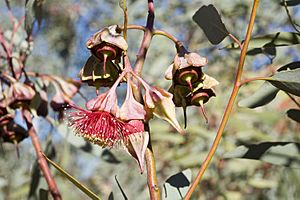Wing-fruited mallee facts for kids
The Wing-fruited Mallee, known scientifically as Eucalyptus alatissima, is a special type of eucalypt tree. It grows only in the central areas of the Great Victoria Desert in Australia. This plant has rough bark near the ground. Higher up, its bark is smooth and can be tan or cream-colored. It has leaves shaped like eggs or spears. Its flower buds grow in groups of three. These buds look powdery and have clear wing-like shapes on them.
Quick facts for kids Wing-fruited mallee |
|
|---|---|
 |
|
| Eucalyptus alatissima in the Adelaide Botanic Garden | |
| Scientific classification | |
| Genus: |
Eucalyptus
|
| Species: |
alatissima
|
| Synonyms | |
|
|
Contents
What the Wing-fruited Mallee Looks Like
Eucalyptus alatissima is usually a mallee, meaning it has many stems growing from the ground. Sometimes, it can be a single-stemmed tree. It typically grows up to 8 metres (26 ft) tall.
Its bark is smooth and tan to cream-colored on the upper parts of its stems. Closer to the ground, the bark is rough and grey. It can look like fibers or ribbons.
Young plants have dull, bluish leaves that are egg-shaped or broadly spear-shaped. They often have a powdery surface. Adult leaves are dull green to grey-green. They are egg-shaped to spear-shaped, about 60–100 millimetres (2.4–3.9 in) long and 15–20 mm (0.6–0.8 in) wide.
The flowers grow in groups of three, called umbels. They appear where the leaves meet the stem (in the leaf axils). The mature flower buds are reddish and can be round or oval. They are about 32–45 millimetres (1.3–1.8 in) long and 15–30 mm (0.6–1.2 in) wide.
Both the flower cup (called the hypanthium) and the cap (called the operculum) of the buds are powdery. They also have clear wing-like ridges running along them. The cap is longer than the flower cup.
This plant blooms between July and October. It produces inflorescences (flower clusters) with pink to red flowers. Sometimes, the flowers can be yellow.
After flowering, the plant produces woody fruits called capsules. These fruits are about 14–20 mm (0.55–0.79 in) long and 25–45 mm (0.98–1.77 in) wide. They have strong, wing-like ridges along their length. Inside the fruits are dark grey, pyramid-shaped seeds, about 4 mm (0.16 in) long.
How the Wing-fruited Mallee Got its Name
This eucalypt was first officially described in 1993. Two botanists, Ian Brooker and Stephen Hopper, named it Eucalyptus kingsmillii subspecies alatissima. They published their findings in a science journal called Nuytsia.
Later, in 2013, another botanist named Dean Nicolle changed its status. He decided it was different enough to be its own species. He then called it Eucalyptus alatissima in his book Native eucalypts of South Australia.
Sometimes, people mistakenly call Eucalyptus kingsmillii or Eucalyptus pachyphylla by this name.
The second part of the scientific name, alatissima, comes from Latin. It means "most winged" or "very much so." This name refers to the very clear wing-like shapes on its buds and fruits.
Where the Wing-fruited Mallee Lives
This mallee grows in specific types of soil. It likes gravelly red sands and loam. You can find it in areas with mallee plants or mulga scrub.
It grows near the border between South Australia and Western Australia. It is found in the central parts of the Great Victoria Desert. Its range stretches from Vokes Hill in South Australia to Neale Junction. Neale Junction is east of Laverton in Western Australia. It also grows in parts of the Goldfields region.
Protecting the Wing-fruited Mallee
The Western Australian Government's Department of Parks and Wildlife has looked at the status of Eucalyptus alatissima. They have classified it as "not threatened" in Western Australia. This means it is not currently at risk of disappearing.

